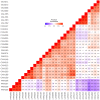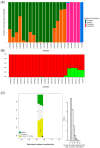Population Genomics of the Critically Endangered Brazilian Merganser
- PMID: 38136797
- PMCID: PMC10741106
- DOI: 10.3390/ani13243759
Population Genomics of the Critically Endangered Brazilian Merganser
Abstract
The Brazilian merganser (Mergus octosetaceus) is one of the most endangered bird species in South America and comprises less than 250 mature individuals in wild environments. This is a species extremely sensitive to environmental disturbances and restricted to a few "pristine" freshwater habitats in Brazil, and it has been classified as Critically Endangered on the IUCN Red List since 1994. Thus, biological conservation studies are vital to promote adequate management strategies and to avoid the decline of merganser populations. In this context, to understand the evolutionary dynamics and the current genetic diversity of remaining Brazilian merganser populations, we used the "Genotyping by Sequencing" approach to genotype 923 SNPs in 30 individuals from all known areas of occurrence. These populations revealed a low genetic diversity and high inbreeding levels, likely due to the recent population decline associated with habitat loss. Furthermore, it showed a moderate level of genetic differentiation between all populations located in four separated areas of the highly threatened Cerrado biome. The results indicate that urgent actions for the conservation of the species should be accompanied by careful genetic monitoring to allow appropriate in situ and ex situ management to increase the long-term species' survival in its natural environment.
Keywords: Brazilian Cerrado; anseriformes; conservation genetics; endangered species; neotropical bird; neotropics.
Conflict of interest statement
The authors declare that they have no conflict of interest.
Figures







References
-
- IUCN Mergus octosetaceus: BirdLife International: The IUCN Red List of Threatened Species 2019. [(accessed on 7 November 2023)]. Available online: https://www.iucnredlist.org/species/22680482/143756439.
-
- Hughes B., Dugger B., Cunha H.J., Lamas I., Goerck J., Lins L., Silveira L.F., Andrade R., Bruno S., Rigueira S., et al. Plano de Ação para a Conservação do Pato-Mergulhão: Mergus octosetaceus. IBAMA; Brasília, Brazil: 2006.
-
- Schiegg K., Daniels S.J., Walters J.R., Priddy J.A., Pasinelli G. Inbreeding in red-cockaded woodpeckers: Effects of natal dispersal distance and territory location. Biol. Conserv. 2006;131:544–552. doi: 10.1016/j.biocon.2006.03.001. - DOI
-
- IUCN The IUCN Red List of Threatened Species. [(accessed on 14 November 2023)]. Available online: https://www.iucnredlist.org/en.
Grants and funding
LinkOut - more resources
Full Text Sources

